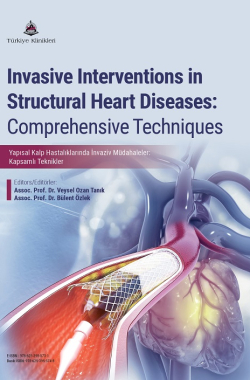TRANSSEPTAL PUNCTURE: INDICATIONS,ANATOMICALCONSIDERATIONS, TECHNIQUES AND COMPLICATIONS
Serdal Baştuğ
Ankara Yıldırım Beyazıt University, Faculty of Medicine, Ankara Bilkent City Hospital, Department of Cardiology, Ankara, Türkiye
Baştuğ T. Transseptal Puncture: Indications, Anatomical Considerations, Techniques and Complications. In: Tanık VO, Özlek B, editors. Invasive Interventions in Structural Heart Diseases: Comprehensive Techniques. 1st ed. Ankara: Türkiye Klinikleri; 2025. p.83-91.
ABSTRACT
Transseptal puncture (TP) is the procedure of accessing the left atrium (LA) by puncturing the interatrial septum (IAS) using a needle and specialized catheters. The LA is the most challenging heart chamber to enter percutaneously; it is attainable through the left ventricle and the mitral valve, but this approach requires two consecutive 180-degree catheter turns, which a 180-degree catheter turns, which can be technically demanding. TP allows direct access to the LA through the intra-atrial septum and systemic venous system. For these reasons, transseptal puncture is a special procedure that has serious complications and requires experience and has become popular again in recent years due to the increase in ablation procedures.
Keywords: Transseptal puncture; Complications; Technique
Kaynak Göster
Referanslar
- Ross J, JR. Braunwald E, Morrow AG. Transseptal left atrial puncture; new technique for the measurement of left atrial pressure in man. Am J Cardiol.1959;3(5):653-5. [Crossref] [PubMed]
- De Ponti R, Cappato R, Curnis A, Della Bella P, Padeletti L, Raviele A, et al. Trans-septal catheterization in the electrophsiology laboratory: data from a multicenter survey spanning 12 years. J Am Cardiol.2006;47(5):1037-42. [Crossref] [PubMed]
- Price MJ, Valderrabano M, Zimmerman S, Friedman DJ, Kar S, Curtis JP, et al. Periprocedural pericardial effusion complicating transcatheter left atrial appendage occlusion: a report from the NCDR LAAO Registry. Circ Cardiovasc Interv. 2022;(5):e011718. [Crossref]
- Tsun Jui L, Hui Chin L, Wen Lieng L, Kuo Yang W, Tsu Juey W, et al. Immediate and late outcomes of patients undergoing transseptal left-sided heart catheterization for symptomatic valvular and arrhythmic diseases American Heart Journal Volume 151, Issue 1, January 2006:235-241. [Crossref] [PubMed]
- Maclean E, Mahtani K, Roelas M, Vyas R, Butcher C, Ahluwalia N, et al. Transseptal puncture for left atrial ablation: Risk factors for cardiac tamponade and a proposed causative classification system. J Cardiovasc Electropysiol. 2022;33(8):1747-55. [Crossref] [PubMed] [PMC]
- Clakins H, Hindricks G, Cappota R, Kim YH, Saad EB, Aguinaga L, et al. 2017 HRS/EHRA/ECAS/APHRS/SOLAECE expert consensus statement on catheter and surgical ablation of atrial fibrillation. Heart Rythm. 2017;14(10):e275-e244. [Link]
- Damian D, Mateusz K.H. Interatrial septum as a possible source of thromboembolic events. Translational Research in Anatomy 27 (2022)100190. [Crossref]
- Francesco F.F, Luigi B, Giovanni P, Marco M, Elena P, et al. Echocardiographic-Fluoroscopic Fusion Imaging in Transseptal Puncture: A New Technology for an Old Procedure. Journal of the American Society of Echocardiography 2017;30(9):886-895 [Crossref] [PubMed]
- Giulio Russo, MD, PhD; Maurizio Taramasso, MD, PhD; Francesco Maisano, MD. Transseptal puncture: procedural guidance, challenging situations and management of complications. Eurointervention 021;17:720-727. [Crossref] [PubMed] [PMC]
- Adamczyk M, Niedziela JT, Wasilewski J, Zembala MO, Kalarus Z, Gąsior M. Prevalence, management and outcomes of cardiac tamponade complicating 66,812 invasive cardiac procedures: single-center clinical registry. Postep w Kardiol Interwencyjnej. 2021;17:193:199. [Crossref] [PubMed] [PMC]
- Edd M, Karishma M, Marina R, Rohan Vyas BHs, Charles B, et al. Transseptal puncture for left atrial ablation: Risk factors for cardiac tamponade and a proposed causative classification system. J Cardiovasc Electrophysiol.2022;33:1747-1755. [Crossref] [PubMed] [PMC]
- Cappato R, Calkins H, Chen SA, et al. Updated worldwide survey on the methods, efficacy, and safety of catheter ablation for human atrial fibrillation. Circ Arrhythm Electrophysiol 2010;3:32-8. [Crossref] [PubMed]
- Letsas KP, Pappas LK, Gavrielatos G, et al. ST-segment elevation induced during the transseptal procedure for radiofrequency catheter ablation of atrial fibrillation. Int J Cardiol 2007;114:e12-14. [Crossref] [PubMed]

